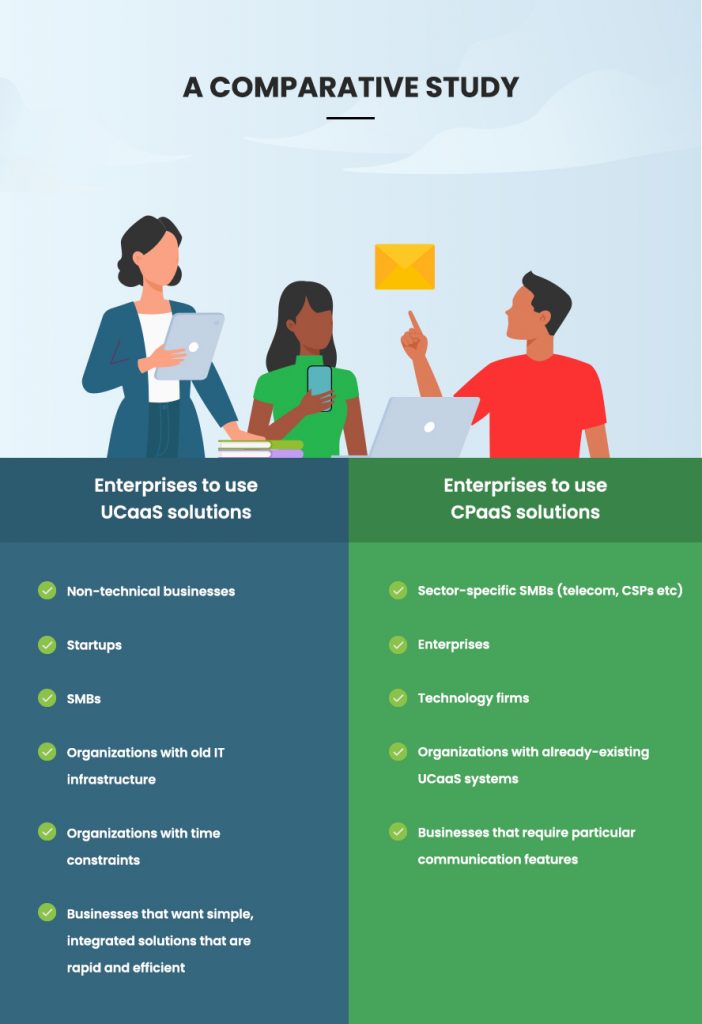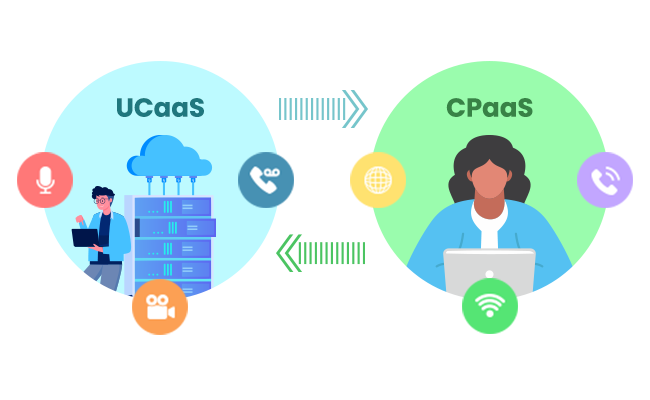As enterprises require greater flexibility to cater to in-office, hybrid, or remote working skilled professionals, frontline employees, and contact center agents, the need for cloud-based communications has increased more than ever.
A growing number of businesses are switching from on-premise to cloud-based communication technology, and many are making important decisions about how to construct their communication stack. Do they use CPaaS to add new features and options to already-existing technology, or do they search for a whole communication solution using UCaaS?
What is UCaaS?
The term UCaaS stands for ‘unified communications as a service.’ It combines message and phone services via the internet into a fully functional communication medium. UCaaS providers give their customers access to a centralized network. You will have access to real-time communication, other applications, and telephone and video conferencing in addition to these, so that staff members may check-in and share data about what they are engaged in.
UCaaS is a crucial service for a business since it maintains workplace cohesion even when employees are dispersed. To know where everyone is and what they’re doing, whether you have a centralized office or a scattered workforce, you need to use phones, video conferencing, texting, and monitoring tools.
Voice, video, text, teamwork, and the cloud are the five primary elements of UCaaS. By implementing UCaaS, managers will have access to their employees’ workflows and will be given more opportunities for employee collaboration.

Working remotely and in a hybrid environment while having access to all communications is a terrific alternative that UCaaS provides. Businesses that require a lot of travel for employees would profit from it.
UCaaS vendors are also very attentive about security. This is perfect for both safeguarding customers’ information and enterprise communication. Customers also benefit from the variety of communication possibilities.
What is CPaaS?
Platform as a Service, also known as PaaS, includes CPaaS which stands for Communication Platform as a Service.
It offers developers a simple means of enhancing and integrating direct, real-time user-to-user communication on an already-existing application without the requirement for a separate program. An everyday illustration of CPaaS is a chat window that appears to assist you as you browse a website.
CPaaS solutions enable businesses to create real-time communication services (including audio, video, and messaging) that can be immediately integrated into commercial apps and software in a world where customers prefer direct, genuine engagements.
As users depend mostly on their mobile devices, organizations are discovering how crucial it is to incorporate a communications strategy and solution that enables them to reach customers wherever they are.
COVID has played a significant role in the market’s expansion for CPaaS. The year 2020 served as a wake-up call for many traditional businesses, who realized that they could no longer keep aside the aspect of developing digital relationships with their customers.
Large, global corporations were unexpectedly faced with the challenge of fundamentally altering how they engaged with customers, offering more than just a helpline and a mobile app, and CPaaS solutions provided a way to respond quickly while still providing high-quality services without letting their organization suffer.
Differences between UCaaS and CPaaS
The primary distinction between UCaaS and CPaaS is how each platform is oriented. While UCaaS is a comprehensive communications solution like Zoom, Google Meet, and Teams, CPaaS is intended to add communications to already-existing applications.
With the help of CPaaS, enterprises can add communications features to their current apps. They can access real-time phone and video calling, texting, and more with a CPaaS. Also, companies can get a full set of networking and collaboration tools from UCaaS. In addition to other features, the platform offers VoIP, video conferencing, instant messaging, and presence management.
CPaaS is frequently more beneficial for supporting customer-facing communication while UCaaS is typically utilized for internal communication. It’s hardly surprising that UCaaS has become more and more well-liked as companies have been driven to accept remote and hybrid work. Contrarily, CPaaS is a far more recent addition to the extensive list of aaS, but for companies with the requisite programming expertise, its popularity is surging.
Usage of UCaaS and CPaaS in the modern workplace
Both UCaaS and CPaaS give businesses access to more efficient communication tools. With people working from various locations and using various devices, the modern workplace is becoming more mobile and decentralized. It has led to a demand for more adaptable and user-friendly communications solutions. These requirements are addressed by CPaaS and UCaaS platforms, which enable companies to create unique communications workflows using their apps, processes, and technologies.
In a modern workplace, an employee interacts and cooperates using their PCs, cellphones, and tablets from any location at any time. They use a variety of contact channels, including emails, voicemail, video, WhatsApp API and texting. The issue is that there are so many various kinds of communication that the message frequently fragments. This is where UCaaS and CPaaS complete the roadmap.
Consumers may receive literally the entire message regardless of where they are accessing it or how they are receiving it thanks to unified communication solutions, which merge the appropriate communication functions into one platform. Users may go from team chat to a video conference with just one click, launching and signing into a new application without losing their place in the conversation. CPaaS is frequently utilized to provide messaging and programmatic voice capability to applications. UCaaS is focused on more extensive communication and teamwork, such as video calls.
What do these differences mean for your business?
There isn’t a single approach that works for all company communications. Both the UCaaS and CPaaS models are unique approaches that excel in various situations. In short, UCaaS is a simpler technology that does not require any additional work, and users may make use of a wide range of communication options. On the contrary, CPaaS necessitates technical developer expertise because users must plan their own applications and choose which features to include in their communication models.
If you require a complete communication suite, go with UCaaS. However, if you prefer your software engineers to construct according to your strategy and with the necessary funding, go with CPaaS.
Benefits of UCaas and CPaaS
UCaaS offers businesses several advantages, such as:
- Reduced expenses for setting up and maintaining communication systems
- A complete set of tools for communicating and working together
- Improved communication and collaboration that results in increased efficiency
- Transfer of administrative duties to the service provider
- Enhanced flexibility and scaling
- Better reliability
Enterprises can profit from CPaaS in a number of ways, such as:
- The capacity to create unique communications features that can be incorporated into the processes of already-existing applications
- Integrating a wide range of services, like live audio and video calling, texting, and chatbots, into an already-existing program
- Increased adaptability in how firms interact with both staff and clients
- Reduced expenses for setting up and maintaining communication networks
Which approach should you choose?
The same functionalities are covered and the same problems for businesses are addressed by both UCaaS and CPaaS. Picking just one kind of solution is the best step in this process.
But which one is ideal for you? Smaller businesses that want dependable functioning and increased worker mobility frequently use UCaaS. Smaller businesses typically lack the funding necessary to build a unified communications infrastructure as reliable as industry-standard commercial solutions.
Enterprises of the following types are likely to employ UCaaS solutions:
- Non-technical businesses
- Startups
- SMBs
- Organizations with old IT infrastructure
- Organizations with time constraints
- Businesses that want simple, integrated solutions that are rapid and efficient
Enterprises that need to add specific capabilities to a current networking model or infrastructure frequently employ CPaaS solutions. Furthermore, particular features might be repackaged as white-label aspects or even a standalone program. Businesses of the following sorts are likely to adopt CPaaS solutions:
- Sector-specific SMBs (telecom, CSPs etc).
- Enterprises.
- Technology firms.
- Organizations with already-existing UCaaS systems.
- Businesses that require particular communication features.

Integrated platforms bring UCaaS, CCaaS, and CPaaS together
In order to support the Software as a Service (SaaS) revolution, cloud services including the cloud call center solution and call center software have expanded, and the contact center has gotten on board. Solutions for Contact Centre as a Service, or CCaaS, can help companies develop contact center capabilities with a slow ramp-up of employees and without excessive infrastructure upgrades.
The goal to connect with a client is at the core of CCaaS, and as a result, CCaaS and the communication technology found in UCaaS and CPaaS products have a lot in common. The incorporation or integration of customer relationship management technology is distinctive to CCaaS.
To stand out from the competition in the market, some UCaaS vendors have started to provide integrated platforms that incorporate CCaaS and CPaaS. Enterprises can eliminate communication platform barriers by combining the three technologies i.e. UCaaS, CCaaS, and CPaaS together.
The advantages of an integrated platform for all three technologies include a single system for IT to maintain, a single policy for data storage and gathering consumer data, and a single framework for privacy, transparency, and accountability.


